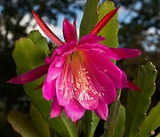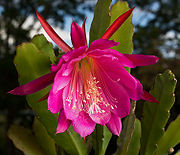
Epiphyllum
Encyclopedia
- For the genus Epiphyllum Pfeiff., see its synonym SchlumbergeraSchlumbergeraSchlumbergera is a genus of cactus from the coastal mountains of south-eastern Brazil. Plants grow on trees or rocks in habitats which are generally shady with high humidity and can be quite different in appearance from their desert-dwelling cousins...
.

Greek language
Greek is an independent branch of the Indo-European family of languages. Native to the southern Balkans, it has the longest documented history of any Indo-European language, spanning 34 centuries of written records. Its writing system has been the Greek alphabet for the majority of its history;...
) is a genus
Genus
In biology, a genus is a low-level taxonomic rank used in the biological classification of living and fossil organisms, which is an example of definition by genus and differentia...
of 19 species
Species
In biology, a species is one of the basic units of biological classification and a taxonomic rank. A species is often defined as a group of organisms capable of interbreeding and producing fertile offspring. While in many cases this definition is adequate, more precise or differing measures are...
of epiphytic
Epiphyte
An epiphyte is a plant that grows upon another plant non-parasitically or sometimes upon some other object , derives its moisture and nutrients from the air and rain and sometimes from debris accumulating around it, and is found in the temperate zone and in the...
plant
Plant
Plants are living organisms belonging to the kingdom Plantae. Precise definitions of the kingdom vary, but as the term is used here, plants include familiar organisms such as trees, flowers, herbs, bushes, grasses, vines, ferns, mosses, and green algae. The group is also called green plants or...
s in the cactus
Cactus
A cactus is a member of the plant family Cactaceae. Their distinctive appearance is a result of adaptations to conserve water in dry and/or hot environments. In most species, the stem has evolved to become photosynthetic and succulent, while the leaves have evolved into spines...
family (Cactaceae), native to Central America
Central America
Central America is the central geographic region of the Americas. It is the southernmost, isthmian portion of the North American continent, which connects with South America on the southeast. When considered part of the unified continental model, it is considered a subcontinent...
. Common names for these species include orchid cacti and leaf cacti, though the latter also refers to the genus Pereskia
Pereskia
Pereskia is a genus of about 25 tropical species and varieties of cacti that do not look much like other types of cacti, having substantial leaves and thin stems. They originate from the region between Brazil and Mexico. The genus is named after Nicolas-Claude Fabri de Peiresc, a 16th century...
.
The stems are broad and flat, 1-5 cm broad, 3-5 mm thick, usually with lobed edges. The flower
Flower
A flower, sometimes known as a bloom or blossom, is the reproductive structure found in flowering plants . The biological function of a flower is to effect reproduction, usually by providing a mechanism for the union of sperm with eggs...
s are large, 8-16 cm diameter, white to red, with numerous petals.
The fruit
Fruit
In broad terms, a fruit is a structure of a plant that contains its seeds.The term has different meanings dependent on context. In non-technical usage, such as food preparation, fruit normally means the fleshy seed-associated structures of certain plants that are sweet and edible in the raw state,...
is edible, very similar to the pitaya
Pitaya
A pitaya or pitahaya is the fruit of several cactus species, most importantly of the genus Hylocereus . These fruits are commonly known as dragon fruit – cf...
fruit from the closely related genus Hylocereus
Hylocereus
Hylocereus is a genus of cacti, often referred to as nightblooming cactus . Several species have large edible fruits, which are known as pitaya or dragonfruits.-Taxonomy:...
, though not so large, being only 3-4 cm long.

Cultivar
A cultivar'Cultivar has two meanings as explained under Formal definition. When used in reference to a taxon, the word does not apply to an individual plant but to all those plants sharing the unique characteristics that define the cultivar. is a plant or group of plants selected for desirable...
s. The broad-leaved epiphyllum (Epiphyllum oxypetalum
Epiphyllum oxypetalum
Epiphyllum oxypetalum is a species of cactus and one of the most cultivated species in the genus. It is a variety of nightblooming Cereus and often confused with species of Selenicereus.-Synonymy:*Cereus oxypetalus Moc. & Sesse ex de Candolle Prodr...
) is particularly well-known. It bears large, strongly fragrant flowers, that bloom for a single night only.
Epiphyllum species are added to some versions of the hallucinogenic drink Ayahuasca
Ayahuasca
Ayahuasca is any of various psychoactive infusions or decoctions prepared from the Banisteriopsis spp. vine, usually mixed with the leaves of dimethyltryptamine-containing species of shrubs from the Psychotria genus...
.
Selected species
|
Epiphyllum oxypetalum Epiphyllum oxypetalum is a species of cactus and one of the most cultivated species in the genus. It is a variety of nightblooming Cereus and often confused with species of Selenicereus.-Synonymy:*Cereus oxypetalus Moc. & Sesse ex de Candolle Prodr... (DC.) Haw. Epiphyllum phyllanthus Epiphyllum phyllanthus, commonly known as the climbing cactus is a species of epiphytic cacti. It has no leaves, instead having stems that photosynthesise... (L.) Haw. Epiphyllum pumilum Epiphyllum pumilum is a cactus species native to Mexico and Guatemala. The species is commonly grown as an ornamental for its beautiful, fragrant flowers in the summer.-Etymology:... Britton & Rose |
Formerly placed here
- Disocactus phyllanthoidesDisocactus phyllanthoidesDisocactus phyllanthoides, Nopalxochitl or German Empress, is a species of Cactaceae and is commonly grown as an ornamental cactus pot plant. It is one of the three major species involved in creating the widely grown Orchid Cactus or "Epies"...
(DC.) Barthlott (as E. phyllanthoides (DC.) Sweet
External links
- Epiphyllum Society of America - the International Registration Authority for epiphytic cactus hybrids of the Tribe Hylocereeae
- Epi Species (GotEpis.com), a comprehensive list of genera of epiphytic cacti.
- Kadupul: the midnight miracle, life cycle of an Epiphyllum flower.

